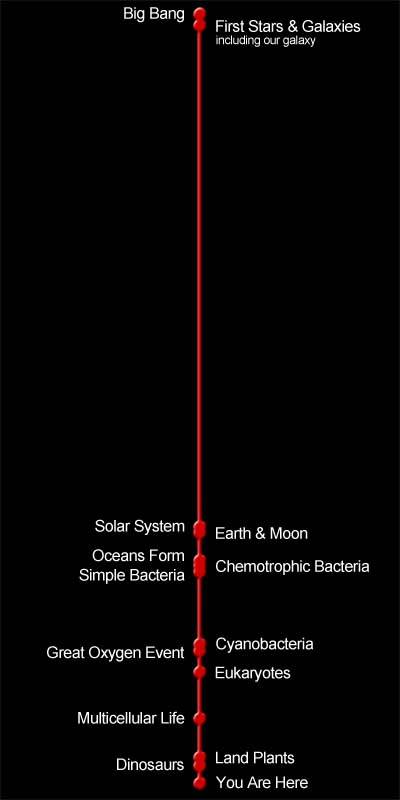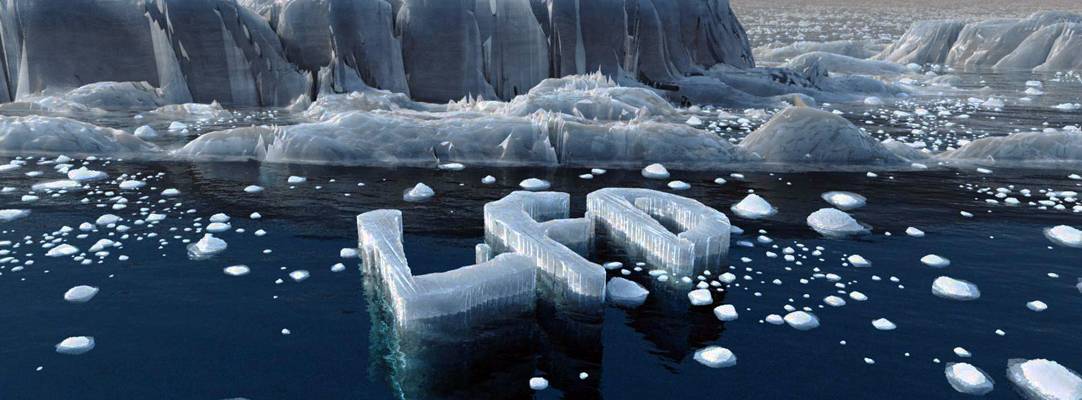13.79 Billion Years in a Nutshell
The age of the universe is estimated to be 13.7965 billion years (refer to notes). Here is what that looks like on a line with high level events picked out.

Page Contents
The First Second

Big Bang + Planck Epoch
At 0 seconds for 10-43 seconds
Time, space, energy and matter came into being in a region of about 10-35 meters in diameter.

Grand Unification Epoch
At 10-43 seconds for 10-36 seconds
Gravity becomes an individual force. Elementary particles and anti-particles are created.

Inflationary Epoch
At 10-36 seconds for 10-32 seconds
The strong nuclear force separates and causes the universe to expand rapidly from size of a proton to about 4 inches in diameter (cosmic inflation).

Electroweak Epoch
At 10-36 seconds for 10-12 seconds
The universe is composed of radiation. The Higgs force and the W and Z bosons emerge, providing the means for matter to exist.

Quark Epoch
At 10-12 seconds for 10-6 seconds
Matter/anti-matter quarks, electrons and neutrinos are created and destroyed; a small fraction of the matter remains.

Hadron Epoch
At 10-6 seconds for 1 second
Quarks combine to form hadrons such as protons and electrons.
The First Minutes

Lepton Epoch
At 1 minute for 3 minutes
Leptons and anti-leptons annihilate each other, releasing photons.

Nucleosynthesis
At 3 minutes for 20 minutes
Nuclear fusion produces hydrogen, helium and traces of lithium while the ambient temperature is high enough to do so.
The First Thousands of Years

Photon Epoch
At 3 minutes for 24,000 years
The dominant energy is held by photons which interact frequently with atomic nuclei, protons and free electrons.

Recombination
24 thousand years elapsed (0.0%)
Free electrons combine with the nuclei of hydrogen, helium and traces of lithium, making the universe transparent for the first time. Photons no longer have baryons to interact with and are released. They become today’s ‘cosmic microwave background’ (CMB).

Dark Era
300 thousand years elapsed (0.0%)
Photons and atoms exist. The expansion, cooling and gravitational attraction continues.
The First Millions of Years

Re-ionisation
150 million years elapsed (1.1%)
Quasars created by gravitational attraction ionise the universe.

First Stars and Galaxies
200 million years elapsed (1.4%)
Gravity creates short-lived super-massive Population III stars that generate the first visible light. These are gas giants that create carbon, nitrogen, oxygen, silicon, magnesium and iron. After a relatively short lifespan, they end in a supernovae explosion. The oldest stars in our galaxy date back to this time. The initial wave of Population III stars provides the material for longer-lived population II and I stars.
The Last Billion Years

Solar System Formation
4.6 billion years ago (66.7% elapsed)
An exploding star started the collapse of a cloud of gas which began to pull together under its own gravity, causing it to rotate. The central mass commences nuclear fission and becomes a star. A similar process of accretion occurs in the circulating disc to make planets.

Earth and Moon Created
4.5 billion years ago (67.4% elapsed)
The moon is thought to have been created from a collision between a young Earth and a large planetesimal, about the size of Mars. Some of the ejected material remains in orbit around Earth and coalesces to become the moon.

Oceans Form
4.0 billion years ago (71.0% elapsed, 11.1% of Earths history).
The Earth cools and oceans form by precipitation and comet strikes.

Chemotrophic bacteria
3.9 billion years ago (71.7% elapsed, 13.3% of Earths history).
Bacteria harnessing iron-rich flows from hydrothermal vents.

Simple Bacteria
3.8 billion years ago (72.5% elapsed, 15.6% of Earths history).
Single-celled Archaea and prokaryotic bacteria with an unbound nucleus.

Cyanobacteria
2.5 billion years ago (81.9% elapsed, 44.4% of Earths history).
The first fossils were a type of blue-green algae that could photosynthesise and create oxygen.
Run Time: 1:15

Great Oxygen Event
2.3 billion years ago (83.3% elapsed, 48.9% of Earths history).
The increased oxygen levels created by the photosynthesising cyanobacteria is poisonous to most existing life forms. For those that are able to harness it, oxygen can fuel an increased metabolism.

Eukaryotes
2.0 billion years ago (85.5% elapsed, 55.6% of Earths history).
A eukaryote is a complex cell with energy provided by mitochondria. Its genetic material is held in a nucleus.
Run Time: 3:41
The Last Millions of Years

First Land Plants
465 million years ago (96.6% elapsed, 89.7% of Earths history).
The first land plants are thought to have evolved from a class of freshwater green algae called the Charophytes.

Dinosaurs
310 million years ago (97.7% elapsed, 93.1% of Earths history).

You are Here
The world population exceeds 7.4 billion.
A Simulated Galaxy Formation
Run Time: 2:00
This video, showcased by the Royal Astronomical Society, reveals the formation of a single galaxy where colours indicate density. The galaxy sits in a cube of space 230 million light-years in diameter that contains more than 20 billion particles.
A Simulated Universe
Run Time: 4:11
The following video is a computer simulation of the evolution of the universe. The simulation starts 12 million years after the big bang and applies current physics to a cube of space and material 350 million light-years long on each side.
The simulation is generated by a software model called Illustris, created by Mark Vogelsberger and his team at MIT, Boston, USA. Their film has been narrated by Elizabeth Gibney: physics reporter for Nature. Elizabeth clarifies the evolution fully and clearly and her full article can be found over at: www.nature.com (click here).
Notes
The research that has gone into this article is not straightforward. You should be aware that
- There are often a range of possible times marking the same events.
- There is often disagreement over which values are more likely.
- To simplify the presentation, time ranges have been reduced to points in time.
References
- hyperphysics.phy-astr.gsu.edu
- www.space.com
- www.windows2universe.org
- www.physicsoftheuniverse.com
- www.bighistoryproject.com
- www.guide-to-the-universe.com
- www.scientificamerican.com
- exploringorigins.org
- www.ucmp.berkeley.edu
- evolution.berkeley.edu
- www.biologyreference.com
- hyperphysics.phy-astr.gsu.edu
- www.mhhe.com
Disclaimer
Care has been taken to keep the information in this article as accurate as possible but errors are possible, so be aware of the full disclaimer here.
